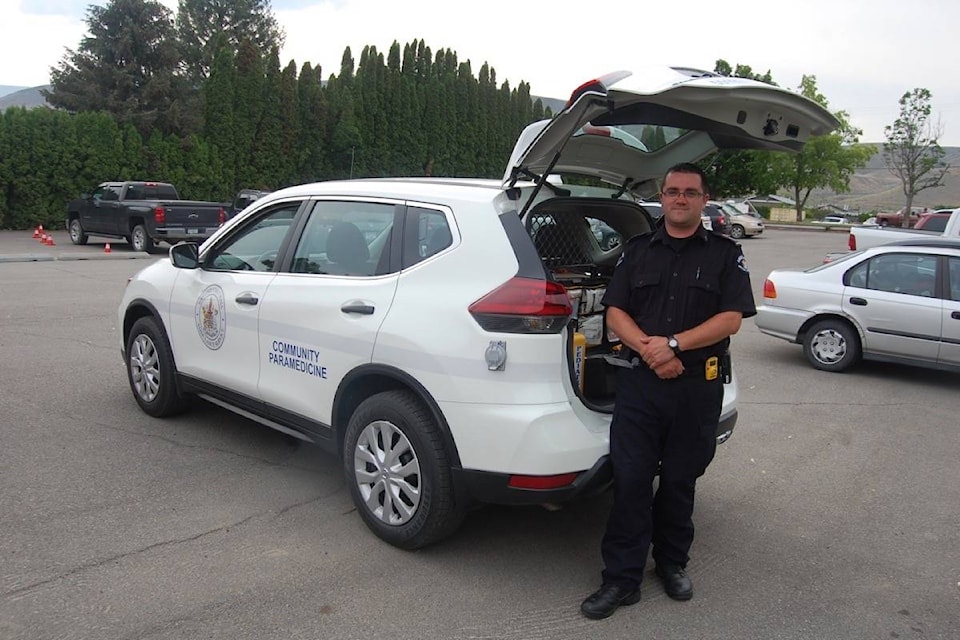The community paramedicine program has come to the Ashcroft-Cache Creek area, and paramedic Philip Schuberg—who grew up here and graduated from Ashcroft Secondary School—says by email that when the opportunity to become a community paramedic came up, “I went for it.”
Schuberg, who will be based out of Ashcroft, began his paramedic career 15 years ago. “Like many paramedics, particularly in rural areas, I began my paramedic career working part-time,” he says, noting that a lot of his time was spent working out of Station 303 in Ashcroft. In 2012 he made the decision to work full-time as a paramedic in the Lower Mainland
He says that he saw the potential benefits of working as a community paramedic in a rural community. “I’ve seen the increased difficulties in receiving health care in rural areas. I like being part of a program that will allow me to offer better access to primary health care, particularly for seniors.
“And being a community paramedic allows me to stay in the community, closer to my family.”
BC Emergency Health Services (BCEHS) has been coordinating the implementation of community paramedicine in the province with the Ministry of Health, the province’s health authorities, and the Ambulance Paramedics of BC (CUPE 873). There are currently more than 100 community paramedics working in rural communities around B.C., which is the first province in Canada to implement a province-wide community paramedicine program.
The program was trialled in nine communities in 2015/16, and in 2017 was expanded to include more than 60 other communities, including Clinton, Lytton, Lillooet, and Logan Lake. It offers residents—primarily seniors—in rural communities enhanced health care services from paramedics. The program broadens the traditional focus of paramedics to include disease prevention, health promotion, and basic health care services.
The community-based model is meant for non-urgent settings, in patients’ homes or in the community, in partnership with local health care providers. Community paramedics help improve access to health care in rural and remote communities by providing services to primarily older adults living with chronic conditions. These services, identified by referring health professionals, are intended to help patients live safely in their homes and avoid extra trips to the hospital.
It also offers rural communities a stabilized paramedic presence for emergency response. Community paramedics have the ability to augment additional shifts in emergency response capabilities. And if there is a significant incident in the community and the community paramedic is the nearest responder, he or she will be contacted by dispatch, and respond if it is determined that it’s safe to leave the patient they are caring for.
All community paramedics are trained and currently working for BCEHS as emergency care paramedics. “I hold the certification of Primary Care Paramedic IV, which indicates I’m endorsed to do intravenous work,” says Schuberg. “My work will be primarily with older adults living with chronic conditions, such as heart failure, pulmonary disease, and diabetes. I’m hoping to help people in our community to self-manage so they can spend less time in health clinics or hospitals.
“Many of the community know me as ‘Philip’, and I hope to meet many more as I begin my work as a community paramedic this month. Local health care teams can make referrals to the community paramedicine program, but I’m also going to be providing public education in the form of clinics and wellness fairs.”
“We’ve seen very positive results in communities where this program has been implemented,” says Chris Hui, the regional training officer for community paramedicine. “There’s been a significant decline in reliance on the health care system, with a 60 per cent decline in people having to go to emergency. They’re managing on their own.
“We can all self-manage, but some people need extra help. The community paramedicine program is all about allowing patients to manage themselves.”
Hui says they try to customize and personalize the program to each community. “There’s lots of discussion with groups about local needs. It’s not a cookie-cutter approach, which gives the program a lot of latitude. We identify gaps and needs to make it as efficient as possible for each community.”
There are three main components to the program, notes Hui: community wellness clinics, a drop-in service to homes, and health promotions, such as the recent “Be a Lifesaver” event, where community members could learn hands-only CPR and AED use. Community paramedics will define what is offered in their communities in terms of clinics and promotions; these could include a nutrition day, sessions with diabetic or respiratory specialists, or a blood sugar clinic. “People can drop in and learn more.”
Home visit registration will start in August, with people typically referred by their family physician or a community nurse. “People can talk to their family physician,” says Hui. “There will also be community promotion days, where people can ask questions. There will probably be a waiting list for home visits fairly quickly.”
He stresses, however, that home visits are not permanent. “They usually last up to three months per person. The goal is to help clients learn skills and know how to manage their own health. We teach them to self-manage, and we also teach their family.
“Our role is more mentoring. We support people on a health journey. There’s the saying about if you give a man a fish, you feed him for a day, but if you teach him how to fish, he has food for life. The whole premise of the community paramedicine program is teaching people how to fish for themselves, so they don’t have to rely on others.”
Hui adds that every community paramedic is a proactive primary care paramedic. “They try to be proactive, not reactive. Historically, people call 9-1-1 and an ambulance shows up. We work with people who are at a higher risk of having to use an ambulance, and are an extra resource in the community. It adds an additional service to the Ashcroft response area.”
editorial@accjournal.ca
Like us on Facebook and follow us on Twitter
